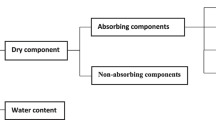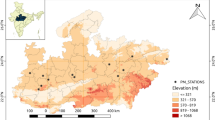Abstract
With rapid urbanization and industrialization, atmospheric pollution and health challenges induced by the escalation of aerosol optical depth (AOD) become severe. Therefore, health risk due to AOD has become a hot research topic these days. In this study, we use the AOD dataset of the MCD19A2 product of MODIS C6 and PM2.5 from 2000 to 2022. This study uses the MAIAC AOD of 13 selected cities to evaluate the spatial and temporal variation of AOD and PM2.5. AOD in Pakistan continuously increased from 2000 to 2022. The average value of AOD is 3.67. The average value of AOD is high in Bahawalpur (0.73). We observe significant differences in the seasonal variation of AOD across Pakistan. Therefore, the highest value of AOD occurred in summer. AOD had the highest value (0.76) in July. The dry areas of Pakistan have a high value of AOD. Dust and anthropogenic activities are the major sources of high AOD in Pakistan. Generally, the AOD is increasing from 2000 to 2022. The population exposure risk is increasing continuously. The regions that are at high risk are (>9) in Punjab (Lahore, Gujranwala, Faisalabad, Bahawalpur, Sialkot, Sahiwal, and Rawalpindi) and Sindh (Karachi, Hyderabad). We also evaluate the slope of the population exposure risk. The slope of the population exposure risk keeps increasing from 2000 to 2022.








Similar content being viewed by others
Data Availability
Data will be made available on reasonable request.
References
Ali, G., Bao, Y., Boiyo, R., Tang, W., Lu, Q., & Min, J. (2019). Evaluating MODIS and MISR aerosol optical depth retrievals over environmentally distinct sites in Pakistan. Journal of Atmospheric and Solar-Terrestrial Physics, 183, 19–35. https://doi.org/10.1016/J.JASTP.2018.12.008
Almazroui, M. (2019). A comparison study between AOD data from MODIS deep blue collections 51 and 06 and from AERONET over Saudi Arabia. Atmospheric Research, 225, 88–95. https://doi.org/10.1016/j.atmosres.2019.03.040
Balkanski, Y., Schulz, M., Claquin, T., & Guibert, S. (2007). Atmospheric Chemistry and Physics Reevaluation of mineral aerosol radiative forcings suggests a better agreement with satellite and AERONET data. Atmospheric Chemistry and Physics, 7, 81–95.
Banerjee, T., Singh, S. B., & Srivastava, R. K. (2011). Development and performance evaluation of statistical models correlating air pollutants and meteorological variables at Pantnagar, India. Atmospheric Research, 99(3–4), 505–517. https://doi.org/10.1016/J.ATMOSRES.2010.12.003
Barreto, Á., Cuevas, E., Granados-Muñoz, M. J., Alados-Arboledas, L., Romero, P. M., Gröbner, J., Kouremeti, N., Almansa, A. F., Stone, T., Toledano, C., Román, R., Sorokin, M., Holben, B., Canini, M., & Yela, M. (2016). The new sun-sky-lunar Cimel CE318-T multiband photometer - A comprehensive performance evaluation. AMT, 9(2), 631–654. https://doi.org/10.5194/AMT-9-631-2016
Bäumer, D., Vogel, B., Versick, S., Rinke, R., Möhler, O., & Schnaiter, M. (2008). Relationship of visibility, aerosol optical thickness and aerosol size distribution in an ageing air mass over South-West Germany. Atmospheric Environment, 42(5), 989–998. https://doi.org/10.1016/J.ATMOSENV.2007.10.017
Bibi, H., Alam, K., Chishtie, F., Bibi, S., Shahid, I., & Blaschke, T. (2015). Intercomparison of MODIS, MISR, OMI, and CALIPSO aerosol optical depth retrievals for four locations on the Indo-Gangetic plains and validation against AERONET data. Atmospheric Environment, 111, 113–126. https://doi.org/10.1016/J.ATMOSENV.2015.04.013
Che, H., Gui, K., Xia, X., Wang, Y., Holben, B. N., Goloub, P., Cuevas-Agulló, E., Wang, H., Zheng, Y., Zhao, H., & Zhang, X. (2019). Large contribution of meteorological factors to inter-decadal changes in regional aerosol optical depth. Atmospheric Chemistry and Physics, 19(16), 10497–10523. https://doi.org/10.5194/ACP-19-10497-2019
Chen, B., Song, Y., Jiang, T., Chen, Z., Huang, B., & Xu, B. (2018). Real-time estimation of population exposure to PM2.5 using mobile- and station-based big data. International Journal of Environmental Research and Public Health, 15(4), 573. https://doi.org/10.3390/IJERPH15040573
Chudnovsky, A., Tang, C., Lyapustin, A., Wang, Y., Schwartz, J., & Koutrakis, P. (2013). A critical assessment of high-resolution aerosol optical depth retrievals for fine particulate matter predictions. Atmospheric Chemistry and Physics, 13(21), 10907–10917. https://doi.org/10.5194/ACP-13-10907-2013
Cohen, A. J., Brauer, M., Burnett, R., Anderson, H. R., Frostad, J., Estep, K., Balakrishnan, K., Brunekreef, B., Dandona, L., Dandona, R., Feigin, V., Freedman, G., Hubbell, B., Jobling, A., Kan, H., Knibbs, L., Liu, Y., Martin, R., Morawska, L., et al. (2017). Estimates and 25-year trends of the global burden of disease attributable to ambient air pollution: An analysis of data from the Global Burden of Diseases Study 2015. The Lancet, 389(10082), 1907–1918. https://doi.org/10.1016/S0140-6736(17)30505-6
Floutsi, A., Korrascarraca, M., Matsoukas, C., & Biskos, G. (2015). The regime of aerosol optical depth over Central Asia based on MODIS Aqua Deep Blue data. Geophysical Research Abstracts, 17, 2015–13428.
Habil, M., Massey, D. D., & Taneja, A. (2016). Personal and ambient PM2.5 exposure assessment in the city of Agra. Data in Brief, 6, 495–502. https://doi.org/10.1016/J.DIB.2015.12.040
Haywood, J., & Boucher, O. (2000). Estimates of the direct and indirect radiative forcing due to tropospheric aerosols: A review. Reviews of Geophysics, 38(4), 513–543. https://doi.org/10.1029/1999RG000078
Hu, X., Waller, L. A., Al-Hamdan, M. Z., Crosson, W. L., Estes, M. G., Estes, S. M., Quattrochi, D. A., Sarnat, J. A., & Liu, Y. (2013). Estimating ground-level PM(2.5) concentrations in the southeastern U.S. using geographically weighted regression. Environmental Research, 121, 1–10. https://doi.org/10.1016/J.ENVRES.2012.11.003
Kaufman, Y. J., Tanré, D., Gordon, H. R., Nakajima, T., Lenoble, J., Frouin, R., Grassl, H., Herman, B. M., King, M. D., & Teillet, P. M. (1997). Passive remote sensing of tropospheric aerosol and atmospheric correction for the aerosol effect. Journal of Geophysical Research: Atmospheres, 102(D14), 16815–16830. https://doi.org/10.1029/97JD01496
Kloog, I., Koutrakis, P., Coull, B. A., Lee, H. J., & Schwartz, J. (2011). Assessing temporally and spatially resolved PM2.5 exposures for epidemiological studies using satellite aerosol optical depth measurements. Atmospheric Environment, 45(35), 6267–6275. https://doi.org/10.1016/J.ATMOSENV.2011.08.066
Koren, I., Kaufman, Y. J., Remer, L. A., & Martins, J. V. (2004). Measurement of the effect of amazon smoke on inhibition of cloud formation. Science, 303(5662), 1342–1345. https://doi.org/10.1126/SCIENCE.1089424/SUPPL_FILE/KOREN.SOM.PDF
Lee, H. J., Liu, Y., Coull, B. A., Schwartz, J., & Koutrakis, P. (2011). A novel calibration approach of MODIS AOD data to predict PM2.5 concentrations. Atmospheric Chemistry and Physics, 11(15), 7991–8002. https://doi.org/10.5194/acp-11-7991-2011
Li, S., Wang, W., Hashimoto, H., Xiong, J., Vandal, T., Yao, J., Qian, L., Ichii, K., Lyapustin, A., Wang, Y., & Nemani, R. (2019). First provisional land surface reflectance product from geostationary satellite Himawari-8 AHI. Remote Sensing, 11(24), 2990. https://doi.org/10.3390/RS11242990
Liu, J., Han, Y., Tang, X., Zhu, J., & Zhu, T. (2016). Estimating adult mortality attributable to PM2.5 exposure in China with assimilated PM2.5 concentrations based on a ground monitoring network. Science of The Total Environment, 568, 1253–1262. https://doi.org/10.1016/J.SCITOTENV.2016.05.165
Lyapustin, A. I., Wang, Y., & Frey, R. (2008). An automatic cloud mask algorithm based on time series of MODIS measurements. Journal of Geophysical Research: Atmospheres, 113(D16), 16207. https://doi.org/10.1029/2007JD009641
Lyapustin, A., Martonchik, J., Wang, Y., Laszlo, I., & Korkin, S. (2011). Multiangle implementation of atmospheric correction (MAIAC): 1. Radiative transfer basis and look-up tables. Journal of Geophysical Research: Atmospheres, 116(D3), 3210. https://doi.org/10.1029/2010JD014985
Lyapustin, A., Tedesco, M., Wang, Y., Aoki, T., Hori, M., & Kokhanovsky, A. (2009). Retrieval of snow grain size over Greenland from MODIS. Remote Sensing of Environment, 113(9), 1976–1987. https://doi.org/10.1016/J.RSE.2009.05.008
Mhawish, A., Sorek-Hamer, M., Chatfield, R., Banerjee, T., Bilal, M., Kumar, M., Sarangi, C., Franklin, M., Chau, K., Garay, M., Kalashnikova, O., & Sorek-Hamer, M. (2021). Aerosol characteristics from earth observation systems: A comprehensive investigation over South Asia (2000-2019). Remote Sensing of Environment, 259, 112410. https://doi.org/10.1016/j.rse.2021.112410
Nguyen, H. M., & Wooster, M. J. (2020). Advances in the estimation of high spatio-temporal resolution pan-African top-down biomass burning emissions made using geostationary fire radiative power (FRP) and MAIAC aerosol optical depth (AOD) data. Remote Sensing of Environment, 248. https://doi.org/10.1016/J.RSE.2020.111971
Prather, K. A., Hatch, C. D., & Grassian, V. H. (2008). Analysis of atmospheric aerosols. Annual Review of Analytical Chemistry, 1(1), 485–514. https://doi.org/10.1146/ANNUREV.ANCHEM.1.031207.113030
Qayyum, F., Tariq, S., & ul-Haq, Z., Mehmood, U., & Zeydan, Ö. (2022). Air pollution trends measured from MODIS and TROPOMI: AOD and CO over Pakistan. Journal of Atmospheric Chemistry. https://doi.org/10.1007/S10874-022-09436-1
Ramachandran, S., Kedia, S., & Srivastava, R. (2012). Aerosol optical depth trends over different regions of India. Atmospheric Environment, 49, 338–347. https://doi.org/10.1016/J.ATMOSENV.2011.11.017
Sahu, S. K., Sharma, S., Zhang, H., Chejarla, V., Guo, H., Hu, J., Ying, Q., Xing, J., & Kota, S. H. (2020). Estimating ground level PM2.5 concentrations and associated health risk in India using satellite based AOD and WRF predicted meteorological parameters. Chemosphere, 255, 126969. https://doi.org/10.1016/J.CHEMOSPHERE.2020.126969
Schuster, G. L., Dubovik, O., & Holben, B. N. (2006). Angstrom exponent and bimodal aerosol size distributions. Journal of Geophysical Research: Atmospheres, 111(D7). https://doi.org/10.1029/2005JD006328
Sharma, A. R., Kharol, S. K., Badarinath, K. V. S., & Singh, D. (2010). Impact of agriculture crop residue burning on atmospheric aerosol loading - A study over Punjab State, India. Annales Geophysicae, 28(2), 367–379. https://doi.org/10.5194/ANGEO-28-367-2010
Sorek-Hamer, M., Chatfield, R., & Liu, Y. (2020). Review: Strategies for using satellite-based products in modeling PM2.5 and short-term pollution episodes. Environment International, 144, 106057. https://doi.org/10.1016/J.ENVINT.2020.106057
Steinle, S., Reis, S., & Sabel, C. E. (2013). Quantifying human exposure to air pollution—Moving from static monitoring to spatio-temporally resolved personal exposure assessment. Science of The Total Environment, 443, 184–193. https://doi.org/10.1016/J.SCITOTENV.2012.10.098
Superczynski, S. D., Kondragunta, S., & Lyapustin, A. I. (2017). Evaluation of the multi-angle implementation of atmospheric correction (MAIAC) aerosol algorithm through intercomparison with VIIRS aerosol products and AERONET. Journal of Geophysical Research: Atmospheres, 122(5), 3005–3022. https://doi.org/10.1002/2016JD025720
Tariq, S. (2015). Spatio–temporal distribution of absorbing aerosols over Pakistan retrieved from OMI onboard Aura satellite. Atmospheric Pollution Research, 6(2), 254–266. https://doi.org/10.5094/APR.2015.030
Tariq, S. (2021). Long-term spatio-temporal trends in aerosol optical depth and its relationship with enhanced vegetation index and meteorological parameters over South Asia. Environmental Science and Pollution Research, 1–18. https://doi.org/10.21203/rs.3.rs-774811/v1
Tariq, S., Qayyum, F., Ul-Haq, Z., & Mehmood, U. (2022). Long-term spatiotemporal trends in aerosol optical depth and its relationship with enhanced vegetation index and meteorological parameters over South Asia. Environmental Science and Pollution Research, 29(20), 30638–30655. https://doi.org/10.1007/S11356-021-17887-4/FIGURES/11
Tariq, S., ul-Haq, Z., Mariam, A., Mehmood, U., & Ahmed, W. (2022). Assessment of air quality during worst wildfires in Mugla and Antalya regions of Turkey. Natural Hazards. https://doi.org/10.1007/S11069-022-05592-5
van Donkelaar, A., Martin, R. V., Brauer, M., Kahn, R., Levy, R., Verduzco, C., & Villeneuve, P. J. (2010). Global estimates of ambient fine particulate matter concentrations from satellite-based aerosol optical depth: development and application. Environmental Health Perspectives, 118(6), 847–855. https://doi.org/10.1289/ehp.0901623
Wei, J., Huang, W., Li, Z., Xue, W., Peng, Y., Sun, L., & Cribb, M. (2019). Estimating 1-km-resolution PM2.5 concentrations across China using the space-time random forest approach. Remote Sensing of Environment, 231. https://doi.org/10.1016/j.rse.2019.111221
Acknowledgements
We are thankful to NASA for providing MODIS MAIAC AOD MCD19A2 product and to Earthdata for providing the data of PM2.5 and WorldPop for population data.
Author information
Authors and Affiliations
Contributions
Maria Nawaz conceptualized the work. Salman Tariq made maps and wrote the manuscript. Ayesha Mariam wrote the manuscript. Zia ul-Haq conducted analysis and wrote the manuscript.
Corresponding author
Ethics declarations
Ethical Approval
Not required
Consent to Participate
Not applicable
Consent for Publication
Not applicable
Competing Interests
The authors declare no competing interests.
Additional information
Publisher’s Note
Springer Nature remains neutral with regard to jurisdictional claims in published maps and institutional affiliations.
Rights and permissions
Springer Nature or its licensor (e.g. a society or other partner) holds exclusive rights to this article under a publishing agreement with the author(s) or other rightsholder(s); author self-archiving of the accepted manuscript version of this article is solely governed by the terms of such publishing agreement and applicable law.
About this article
Cite this article
Nawaz, M., Tariq, S., Mariam, A. et al. Investigating the Variability in Aerosol Optical Depth and Associated Population Exposure Risk in Pakistan Using MAIAC Data. Water Air Soil Pollut 234, 646 (2023). https://doi.org/10.1007/s11270-023-06661-6
Received:
Accepted:
Published:
DOI: https://doi.org/10.1007/s11270-023-06661-6




